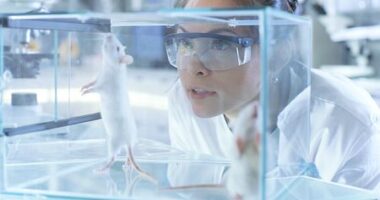First Primate Model of Bardet-Biedl Syndrome May Help Advance Research Efforts for Human Therapy

A naturally occurring nonhuman primate model of Bardet-Biedl syndrome closely mimics the primary features of the condition in humans, including retinal and kidney anomalies, and may help researchers to understand the disease better and to test new therapeutic options.
The model was described in the journal Experimental Eye Research, in a paper titled “Bardet-Biedl Syndrome in rhesus macaques: A nonhuman primate model of retinitis pigmentosa.”
Bardet-Biedl syndrome (BBS) is a rare genetic condition, common symptoms of which include obesity, kidney problems, polydactyly (having more than five fingers on one hand), genital abnormalities, and the degeneration of proteins in the eye that sense light, which is called retinitis pigmentosa.
BBS is caused by mutations in a group of genes — called BBS genes — that encode proteins which are important for the functioning of cilia (small, hair-like projections that cells use to interact with their environment and each other).
Rodent, fish, and roundworm models of BBS have been described but they do not capture the full scope of the disease in humans, particularly with regards to eye function. Human eyes have certain features that are only shared by primates. Thus, a nonhuman primate model of the condition is needed for further research.
In the new study, researchers describe three rhesus macaques that were found to have a mutation in the BBS7 gene. This mutation — called c.160delG — is basically a missing chunk of DNA that could compromise the function of the encoded protein. Although this mutation hasn’t been described in humans, it is functionally similar to some known BBS-causing mutations.
The researchers analyzed the monkeys, and found that all of them had evidence of kidney problems and degeneration of light-sensing proteins in the eye — hallmarks of BBS in humans.
“The phenotype observed in rhesus monkeys with a c.160delG variant in the BBS7 gene parallels key features of human BBS,” the researchers wrote.
However, “the phenotype of this disease is highly variable, and due to the rare occurrence of [mutations in] BBS7, few human reports are available for comparison,” they said.
The researchers noted that larger studies of monkeys with this mutation will be needed to determine the extent to which other features of BBS may or may not appear.
For instance, one of the primary features of BBS in humans is obesity but only one of the three monkeys had a somewhat higher-than-average body weight. This may be due to many factors including, for example, kidney disease in the monkeys, which may have limited their ability to gain weight.
In addition, the one male monkey had relatively small testicles but, because of the small sample size, it would be premature to conclude that all monkeys with this mutation have small genitals.
“Propagation of this model will provide the first nonhuman primate model of retinitis pigmentosa with a known genetic cause, which will be invaluable for preclinical testing of gene, cell-based, and other therapies for this family of blinding disorders,” the researchers said.




